Mark Sisson's Blog, page 68
July 13, 2020
Are Nightshades Bad for You?
 If you’ve spent any amount of time here on Mark’s Daily Apple, you know we love our vegetables. Plant foods are powerhouses of nutrients and antioxidant action. They’re the backbone of a solid Primal diet, and the main event in my signature Big Ass Salad. But the issue of nightshades has come up quite a bit over the years. Nightshade vegetables, which are vegetables that belong to the Solanaceae family of plants, include a long list of veggies and spices: eggplant, potatoes, peppers, tomatoes, tomatillos, pimentos, paprika, cayenne pepper, hot sauce, etc. (Black pepper isn’t a part of this list.)
If you’ve spent any amount of time here on Mark’s Daily Apple, you know we love our vegetables. Plant foods are powerhouses of nutrients and antioxidant action. They’re the backbone of a solid Primal diet, and the main event in my signature Big Ass Salad. But the issue of nightshades has come up quite a bit over the years. Nightshade vegetables, which are vegetables that belong to the Solanaceae family of plants, include a long list of veggies and spices: eggplant, potatoes, peppers, tomatoes, tomatillos, pimentos, paprika, cayenne pepper, hot sauce, etc. (Black pepper isn’t a part of this list.)
I do eat a lot of these foods, but they’re not for everyone. In this article, we’ll dig into why some people simply can’t do nightshades, and how to tell whether you should eat them or not.
Stay on track, even on the go! Instantly download your Primal and Keto Guide to Dining Out
What Are Nightshades?
Nightshade vegetables are the vegetables that grow from plants in the Solanaceae family, which Solanaceae family includes thousands of plants. Only a handful are used for food.
Nightshade Foods
Some of the more common nightshade foods include:
Peppers – hot, bell, sweet, etc.
Cape gooseberry, or ground cherry
Eggplant
Goji berry
Paprika
Pimento
White potato (sweet potatoes don’t count)
Tomato
Tomatillo
This is not an exhaustive list, so if you have a nightshade allergy or intolerance, consult a dietician for a comprehensive list of foods to avoid. Nicotine is a non-food consumable that is included in the nightshade category.
Nightshade Vegetables vs. Deadly Nightshade
Aren’t nightshades those plants (many with alluring little berries) our camp counselors told us never ever to go near? Let’s clear that up first.
The answer is: quite possibly. The kinds of nightshade plants growing wild in the woods can be highly toxic. Some can kill you if you ingest them. Others have psychotropic properties. Simply put, deadly nightshade is poisonous.
Inherent in this power is pharmaceutical potential. Nightshades contain alkaloids, which are chemical substances that have one or more circular structures containing nitrogen, and cause a substantial change in humans. Some natural healers may use very tiny amounts of specific nightshades therapeutically for a range of ails. Because they’re highly toxic, this is not a time for self-experimentation. You could make yourself sick, cause permanent damage to your body, or even die if you use them incorrectly. Always work with a qualified practitioner.
Why Are Nightshades Bad?
Nightshades aren’t bad for everyone. Nightshades contain alkaloids, which are harmful to some humans and innocuous to others. Whether they bother you or not depends on your epigenetics, or how nightshades interact with your genes. People who have problems with nightshades sometimes do not produce the enzymes that break them down.
Nightshade allergy or Intolerance
You can be either allergic to nightshades or intolerant to them, each of which come with different symptoms.
Nightshade Allergy Symptoms
Nightshade allergy symptoms look like the symptoms of allergies to other foods and substances:
Inflammation
Itching
Hives
Skin rashes or flare ups
Aches and pains
Nausea
Vomiting
Nightshade Intolerance Symptoms
The symptoms of nightshade intolerance are usually digestive in nature, including:
Abdominal discomfort
Gas
Bloating
Diarrhea
Indigestion, or heartburn
GERD
Nausea
But what does this mean for the tomato salad I always serve for summer barbecues? Should I give up eggplant parmigiana? No peppers or hot sauce? I thought spicy food was good for me!
Before you raid your kitchen and gardens, let’s stop and take a closer look here.
First off, nightshade foods contain a tiny fraction of the alkaloid levels found in other toxic nightshade plants. If nightshades presented a significant health threat to humans, we would’ve stopped eating them a long time ago or died off from the inability to learn from our neighbor’s experience. Even when nightshade foods are common ingredients in specific ethnic diets (peppers in parts of Latin America or tomatoes in Italy, to give some basic examples), the population as a whole in those parts doesn’t seem to suffer ill effects.
Are Nightshades Bad for You? Answer: It Depends
So, what gives? Are nightshade vegetables evil, or are they okay to eat? Our simple answer: eat them and enjoy them in moderation if you don’t feel any ill effects. Most experts accept that some people are much more sensitive to them than others. Nightshades, in those with this sensitivity, have been associated with symptoms like stomach discomfort, digestive difficulties, joint pain, and muscle tremors.
Sometimes, medical professionals will advise those with certain conditions like GERD, gout, or arthritis to avoid nightshades and see if it alleviates symptoms.
If you don’t have these conditions but are concerned, it’s a good idea to take a full 2-4 weeks off from nightshade foods and see if you feel any differently. Some of us have mild enough reactions that we may not feel the difference until we set our own “control” scenario for comparison.
Finally, if sensitivity doesn’t seem to be a problem, but you’d like to take some reasonable precautions, know that cooking nightshade foods can break down a portion of the alkaloids in nightshades. Yet another reason to avoid potatoes: sprouted potatoes and potatoes turning green have higher levels of alkaloids than they have while fresh.
The bottom line: humans are built to eat a widely varied diet. As much as we love our tomatoes, eggplants, and peppers, we wouldn’t recommend making them the sole or primary vegetables in your diet. Variety offers the best in nutrient-rich and low-risk nourishment, and it keeps things interesting.
What are your thoughts on nightshades? Do you choose to embrace or avoid them? What influences your decision?
The post Are Nightshades Bad for You? appeared first on Mark's Daily Apple.



July 11, 2020
Sugar-free Strawberry Pink Drink (with Violet Drink Variation)
 We’re pushing the peak of summer heat, which means refreshing beverages are an all day, every day requirement. This strawberry pink drink is for those times you want something chilled, creamy, and softly sweet.
We’re pushing the peak of summer heat, which means refreshing beverages are an all day, every day requirement. This strawberry pink drink is for those times you want something chilled, creamy, and softly sweet.
We make ours with collagen, which is something your body needs anyway. No shame in getting hooked on this pink drink, because once the effects of collagen kick in, you may see changes in your skin, hair, and nails that keep you going back for more.
It’s just as easy to make as it is refreshing! If you want to make a berry violet drink instead, use blackberries instead of strawberries and hibiscus tea instead of water.
Enjoy!
Refreshing Strawberry Pink Drink Recipe
Serves: 1
Time in the kitchen: 8 minutes
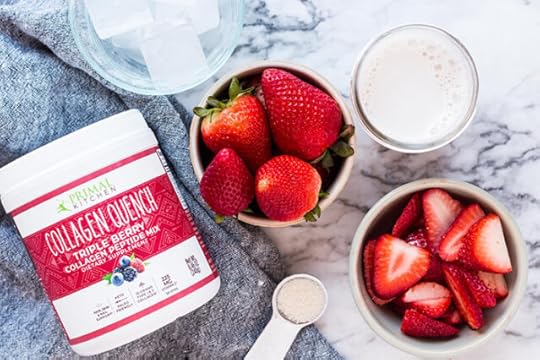
Ingredients
¾ c coconut or almond milk
¾ c + 2 Tbsp. water
½ c chopped strawberries + ¼ c sliced strawberries
2 scoops Primal Kitchen® Collagen Quench Triple Berry Drink Mix
1 tsp. granulated sweetener, optional
ice
Directions
First, create the stewed strawberries for the drink. In a small saucepan, heat the chopped strawberries, 2 tbsp. water and granulated sweetener over medium heat.
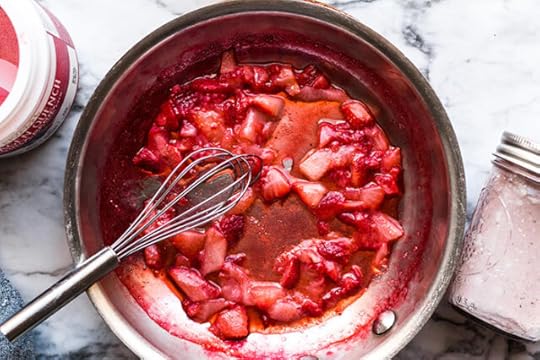 Once they begin bubbling, reduce the heat to medium low and stir for 3-5 minutes, or until the strawberries begin to soften and break down. Set the strawberries aside.
Once they begin bubbling, reduce the heat to medium low and stir for 3-5 minutes, or until the strawberries begin to soften and break down. Set the strawberries aside.
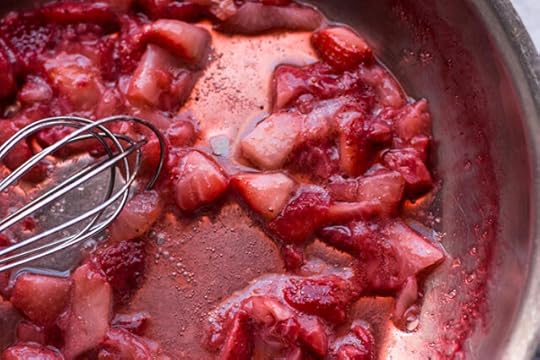
In a jar, mix together the remaining water and Collagen Quench Triple Berry Drink Mix. Shake up until foamy.
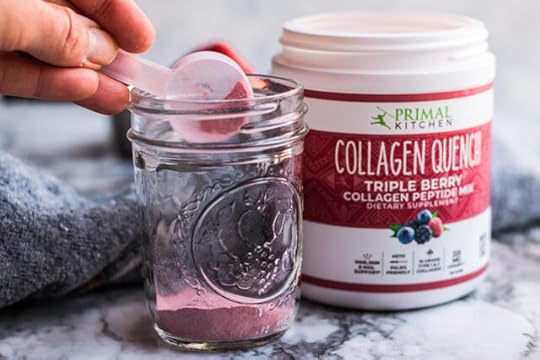 Mix together the berry drink mix with the stewed strawberries and blend in a blender or with an immersion blender. Pour in the milk and blend again for a few seconds.
Mix together the berry drink mix with the stewed strawberries and blend in a blender or with an immersion blender. Pour in the milk and blend again for a few seconds.
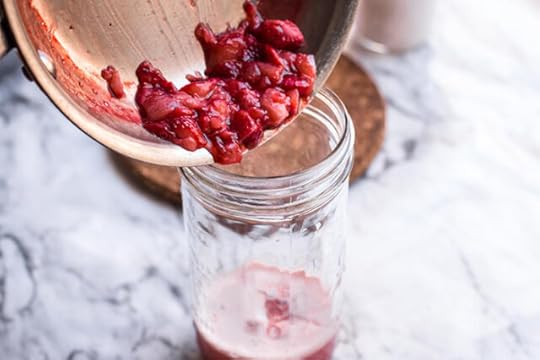 Pour the mixture over ice and garnish with sliced strawberries.
Pour the mixture over ice and garnish with sliced strawberries.
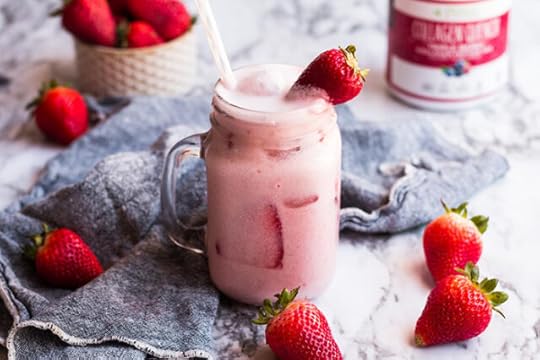
Nutrition Info (serves 1):
Made with almond milk:
Calories: 126
Fat: 3g
Total Carbs: 15g
Net Carbs: 11g
Protein: 11g
Made with full-fat coconut milk:
Calories: 351
Fat: 26g
Total Carbs: 16g
Net Carbs: 13g
Protein: 12g
The post Sugar-free Strawberry Pink Drink (with Violet Drink Variation) appeared first on Mark's Daily Apple.



July 10, 2020
Weekly Link Love — Edition 89

Research of the Week
National handgrip score predicts Olympic medal tally.
Got super high cholesterol? Might be the carbs.
An EVOO-based high-fat diet causes a good kind of gut dysbiosis that lowers the risk of colon cancer.
How time has passed for people during the pandemic: for half it sped up, for half it slowed.
New Primal Blueprint Podcasts
Episode 432: Jon Venus: Host Elle Russ chats with fitness expert Jon Venus, former vegan who’s now embracing ancestral omnivory.
Episode 433: Brian Gryn: Host Brad Kearns chats with Brian Gryn about intermittent fasting.
Primal Health Coach Radio, Episode 68: Laura and Erin get geeky with Dr. Michael Ruscio about gut health.
Media, Schmedia
Homo erectus was a lot stockier than we imagined.
The Mayans had an impressive highway.
Interesting Blog Posts
Where has the time gone?
Malcolm Kendrick has lost faith.
Social Notes
Everything Else
Signaling virtuous victimhood might be a warning sign.
Interesting convo with John Ioannidis.
“I’m a doctor with stage 4 cancer during a pandemic.”
Things I’m Up to and Interested In
I’m not surprised: Spiritual training begets a sense of spiritual superiority.
Interesting important article: About the many benefits of regenerative agriculture.
Interesting important video: Allan Savory on how regenerative agriculture can change the world.
Good overview on the topic: All the research the USDA has ignored on saturated fat.
Great article: Tim Noakes on reversing type 2 diabetes.
Question I’m Asking
In a few days, Robb Wolf and Diana Rodgers are releasing their seminal book on the importance and necessity of regenerative agriculture for both human and planetary health: Sacred Cow. This is important, guys, really important. If you agree, and you think this might just be able to change the world, please consider pre-ordering the book. Once you do, submit your receipt to www.sacredcow.info/book and receive $200 worth of bonus incentives.
Could you do that?
Recipe Corner
Is there anything better than stone fruit with pork? To make this even better, add some burrata.
Fermented rice gruel.
Time Capsule
One year ago (Jul 4 – Jul 10)
8 Tips For Keto on a Budget – Do it on the cheap.
The 5 Best Adaptogens for Stress Reduction – What works?
Comment of the Week
“I stick to the purple rain.”
– I like how you think, Groktimus.
The post Weekly Link Love — Edition 89 appeared first on Mark's Daily Apple.



July 9, 2020
5 Reasons You Can’t Quit Sugar
 Let me guess. You’ve been on keto for 5-6 months and enthusiastically thinking this is how you’ll finally wrangle your sugar cravings into submission! You’re loading up on healthy fats, avoiding grains, and ditching highly processed, high-carb foods. Yet there’s that incessant nagging. You know, the one that tells you that life is too short not to indulge in that giant Costco muffin or the more paleo-friendly version, another square (or three) of dark chocolate.
Let me guess. You’ve been on keto for 5-6 months and enthusiastically thinking this is how you’ll finally wrangle your sugar cravings into submission! You’re loading up on healthy fats, avoiding grains, and ditching highly processed, high-carb foods. Yet there’s that incessant nagging. You know, the one that tells you that life is too short not to indulge in that giant Costco muffin or the more paleo-friendly version, another square (or three) of dark chocolate.
For a lot of people, including my own clients, moving toward a fat- or protein-dominant diet does the trick. You may have seen this article that Mark wrote earlier this year where he says “it takes two to three days of very-low-carb eating for the liver to start pumping out ketones” and that cravings will “decrease noticeably within three to ten days.” Research backs it up too, concluding that cravings are significantly reduced almost immediately as people get into ketosis.1
Things like sleep deprivation, chronic stress, and gut dysbiosis are also shown to cause cravings for a variety of physiological reasons. But let’s say you’re getting a solid 8-9 hours of uninterrupted sleep, your stress levels are under control, your gut microbiome is balanced — and you’re still struggling with cravings. Then what?
Why Can’t I Quit Sugar?
Cravings are often more psychological than they are physiological. Maybe you’ve noticed that too. Maybe you’ve noticed that you start to have cravings any time you have a stressful day or feel anxious or deprived or smell something that reminds you of your favorite snickerdoodle cookie from childhood. In my experience, these are the top 5 emotionally driven reasons you might still be struggling with sugar cravings:
1. Your Diet is Too Restrictive
Eliminating certain foods and food-like items like grains, sugar, and refined carbohydrates is a good thing in general. But being too restrictive — or perceiving how you’re eating as a diet can end up backfiring. In fact, this study shows a direct correlation between food restriction and cravings.2 Researchers looked at food cravings records of 52 women dieting to lose weight and 37 non-dieters and found that the dieters experienced significantly more food cravings, especially for sugary foods like chocolate.
2. Emotional Association
Cravings are tied to the brain’s memory center. From celebrating birthdays and holidays with sugary desserts to being rewarded with a treat for good grades, sugar has always been along for the ride. So, it’s no surprise that when you go to a party or achieve a goal, or even feel down, your sugar cravings might feel irresistible. Not to mention the fact that your hippocampus, caudate, and insula (areas of the brain activated by cravings) 3 are also in charge of housing your memories and experiences.
3. State of Mental Health
Australian researchers conducted a study on pandemic-related depression, stress, anxiety, and well-being and found that 79% of the participants were struggling with mental health issues due to COVID-19.4 If you’ve been dealing with a new routine, financial uncertainty, isolation, or fear, you might be feeling like your cravings are out of control and you’re turning to sugar to cope. As I’m sure you know, sugar consumption (temporarily) increases serotonin, 5 the neurotransmitter that regulates your mood. When you eat sugar, you feel happier, more connected, and less stressed out — at least until the sugar crash hits.
4. Current Rituals
Frozen junior mints at the movies. A slice of pie at summer barbeques. Checking out the dessert menu after dinner even though you’re stuffed. Your rituals and your environment influence your behaviours (i.e. trigger you to search for something sweet).6 And if you have the ritual of consciously or unconsciously seeking out a specific food in a specific situation, you’ll begin to form the expectation that it will occur every single time you’re in that situation.
5. Past Trauma
The Mark’s Daily Apple article I referenced above struck a chord with a lot of readers, with many bravely sharing that they felt their cravings were due to a lack of love and emotional bonding early in life, and therefore a lack of the hormone, oxytocin. Because of this, they began to turn to other things to make themselves feel good, including sugar. Studies not only validate our readers’ experiences, they show the impact of oxytocin on everything from metabolism to chronic illness.7
Why It’s So Hard to Stop Eating Sugar
We’re taught early on that sugar equals love and that feeling “better” is as easy as snuggling a pint of Ben & Jerry’s on the couch. Sure, diving into the emotional side of good health can be uncomfortable, but it’s also extremely necessary if you want to get your cravings under control.
The more readily you can express and deal with your emotions, the healthier your mind and your body will be. In my 10+ years as a health coach, I’ve helped hundreds of men and women peel back the layers of their sugar cravings. And you can too. With the following strategies, you’ll learn that your sugar cravings aren’t something that need wrangling — they’re something that you can use to learn more about what you’re really craving.
How to Cut Your Sugar Habit: 5 Strategies to Stop Cravings
1. Add More Variety
A steady diet of grass-fed beef and local, organic veggies looks great on paper in respect to quality, but as mentioned above, might also feel too limiting for where you’re at right now. If you’re constantly dreaming of sugar-laden treats, take this opportunity to diversify your plate. By adding a variety of colors, textures, and flavors, you’re giving your brain and your body the signal that you’re having more, not less. And don’t forget to change it up now and then. Typically opt for ribeye? Try a salmon fillet. Love salads? Try grilled asparagus. Always snack on almonds? Buy some salted macadamia nuts. You get the picture.
2. Keep a Journal
You don’t have to write down all of your deepest, darkest thoughts, but I do recommend keeping a journal of when your food cravings hit — and this is the important part: what you’re feeling when they come on. Do this exercise without self-editing or judgement. Within a week, my guess is that you’ll start to see a connection between your triggers (which could be memories, celebrations, emotions, people, and places) and your sugar cravings. Research shows that having a practice of mindfulness can help you better manage the uncomfortable feelings that fuel your cravings.8 If you haven’t had the pleasure of tapping into your own awareness, this will be a game changer for you.
3. Ask Yourself What You Need
When you’re feeling stressed, anxious, fearful, or bored, ask yourself what you really need. A few bites of the donut in your kitchen or a quick drive through the Dairy Queen will work, but in reality, you’re just avoiding those uncomfortable feelings by numbing them with food. Be open and honest with yourself about what you need on an emotional level. It could be the comfort of reading a good book, the excitement of getting outside for some exercise, or just holding space to accept where you are in the moment.
4. Create New Rituals
Your past rituals influence your current behaviors, so why not spend some time creating new, healthier rituals? If the sound of dinner dishes being put away sends you running for dessert, think about other post-dinner rituals you could do. Maybe it’s a family walk around the neighborhood or taking a long, relaxing bath. By interrupting your patterns (when dinner ends I look for dessert) you’re able to develop new patterns that work toward your goals, instead of against them.
3. Do More Feel-Good Activities
If you lacked a sense of joy and connection growing up, it’s possible to increase oxytocin9 levels naturally (and reduce the desire to reach for sugar to feel good) through hugging, laughing, playing, and practicing gratitude. Other things like looking at photos of loved ones, singing, physical exercise, and support from family, friends, and our community here on Mark’s Daily Apple are also great ways to boost oxytocin levels. Emotional trauma of any kind can impact your habits and behaviors as an adult. And while a health coach can help you overcome certain obstacles, it’s crucial to work with a licensed professional trained to navigate these challenges 10 and help you move forward safely.
Do any of these reasons or strategies ring true for you? Anything you’d add? Tell me about your experience with emotions and overcoming sugar cravings in the comments.
References https://www.mdpi.com/2072-6643/10/10/1348/htmhttps://www.sciencedirect.com/science/article/abs/pii/S0195666312000219https://www.ncbi.nlm.nih.gov/pmc/articles/PMC4114146/https://www.mobihealthnews.com/news/research-reveals-people-s-mental-health-negatively-impacted-covid-19https://www.researchgate.net/publication/302969772_Effects_of_sugar_rich_diet_on_brain_serotonin_hyperphagia_and_anxiety_in_animal_model_of_both_gendershttps://www.psychologytoday.com/us/blog/habits-not-hacks/201408/want-change-your-habits-change-your-environmenthttps://www.ncbi.nlm.nih.gov/pmc/articles/PMC5868755/https://www.ncbi.nlm.nih.gov/pmc/articles/PMC5435775/https://www.ncbi.nlm.nih.gov/pmc/articles/PMC4290532/https://www.helpguide.org/articles/ptsd-trauma/coping-with-emotional-and-psychological-trauma.htm
The post 5 Reasons You Can’t Quit Sugar appeared first on Mark's Daily Apple.



July 8, 2020
Dear Mark: My Gym is Open, Is It Safe to Go?
 Across much of the world, movement restrictions are lifting, businesses are reopening, and gyms are coming back. While the next few weeks may paint a different picture, and cases are going up in many areas, many places now are seeing better overall trajectories. Deaths are down, which could be a lagging indicator and thus subject to a potential skyrocket. But for now, for better or worse, the gyms are opening.
Across much of the world, movement restrictions are lifting, businesses are reopening, and gyms are coming back. While the next few weeks may paint a different picture, and cases are going up in many areas, many places now are seeing better overall trajectories. Deaths are down, which could be a lagging indicator and thus subject to a potential skyrocket. But for now, for better or worse, the gyms are opening.
Does that mean you should go?
My gym is open. Is it safe to go back?
Hi Mark,
I haven’t been able to get into the gym for several months now. But I just got an email and starting next week, they’re open for business. My question is should I go? Is it safe? What do you recommend?
I’ve really missed the workouts but I also don’t want to get sick.
Now, your regional COVID situation matters. If this is Hawaii and the case count is 1030 with just a few cases being added every day, you’re probably safe going to the gym. If you’re in New York with cases in the hundreds of thousands, the gym might pose more danger. So do your due diligence there. That’s going to vary for everyone.
Let’s say you decide you want to go back. All else being equal, how can you determine if it’s safe to do so? What should you expect from your gym proprietor? What steps can you take to reduce your chances of getting the virus at the gym?
I looked at the actual research into the interactions between gym safety and the coronavirus. I also asked my friend, Thom Downing, who owns the Focused Individualized Trainers facility in Los Altos, CA, for some tips. He’s been closed down for over three months now, and he’s figured out how to keep his coaches paid and his clients fit and healthy by expanding their offerings to include at-home sessions, virtual training, online tutorials, Zoom boot-camps, and even virtual PE classes for kids. He loaned out most of the gym’s equipment to local clients so they can continue their work at home. Plus, he’s been making modifications to the facility so that when he does open back up, his gym will be as safe as possible.
So, what are some things to consider?
I’m offering you a few things to think about. These measures will by no means keep you 100% virus-free. These are simply things to think about as you assess what risk level you are comfortable with.
Wait a Month to See How Things Shake Out
A month is a good period of time to see a trend emerge. If people return and transmission starts happening, you’ll know a month in. Any place of business will (or should) disclose positive COVID19 transmission.
Use Outdoor Equipment
There are many reasons to train outside. Sunlight is a powerful deactivator of the virus and increases your vitamin D production. Having an entire open atmosphere surrounding you instead of a cloistered indoor space provides plenty of room for the exhaled air to disperse and dilute.
This isn’t possible everywhere. Your average big box facility probably won’t let you take weights outside, but the smaller, more mom-and-pop gyms likely will. Ask nicely.
Consider Switching to a Personal Training-style Gym
Smaller, more personal gyms will be your best bet. The user count will be lower. You’ll be familiar with more of the people there. You can avoid people if you need to. People will be doing their own thing, usually with a trainer, and the trainers will all be keeping their clients at a safe distance from other clients because it’s mandated (and correct). It has structure, in other words, and that’s what you need right now.
A big box gym is impersonal, unwieldy. There’s so much going on and so many people you can’t possibly account for. This pushes up the risk of transmission.
Ensure There’s Good Ventilation
A study from 2018 found that the risk of influenza transmission at the gym increased with higher occupancy and higher CO2 levels.1 You could ask your gym to monitor CO2 levels, as those are great barometers for ventilation. Higher CO2 means less ventilation and more shared air. Lower CO2 means higher ventilation, less shared air, and lower risk. Inhaled air is about 0.003% CO2; exhaled air is 4-6% CO2.
That said, “lower risk” doesn’t mean no risk. The same study found that influenza transmission risk remained fairly elevated even with low occupancy and lower CO2 levels. Gyms are just a great vector for a virus like influenza. All that fluid, all that exhalation, all that intensity, all that proximity. COVID19 isn’t influenza, but the two viruses spread through similar mediums: droplets expelled from the nose and mouth.
Fans Over Air Conditioners
Gyms love to pump up the air conditioning. This is helpful when it’s hot out. Safer, even. No one should overheat when training. But when the A.C. is on, the windows are usually closed, and these days, you want good air flow. You don’t want to breathe in the same air everyone else just exhaled.
Favor gyms that have huge industrial fans, open doors and windows, and tons of circulation.
Mask Considerations
The official recommendation is to wear a cloth face covering when you’re around people,2 and masks will likely be required for indoor gyms. At first glance, that seems like it would be uncomfortable, particularly if you’re wearing a legitimate N95 mask. Those things are hard to breathe in.
But researchers have actually looked at this.3 They placed pregnant healthcare workers into N95 masks and had them exercise. They exhaled less oxygen and more carbon dioxide, but that was the extent of the changes. The fetal heartbeats were normal. Blood oxygen saturation didn’t change. Nor did rate of perceived exertion. Overall, it “impose[d] an additional workload on the metabolic system,” which could be good or bad depending on your stress tolerance and goals.
In athletes, wearing a similar mask during weight lifting didn’t affect performance, but it did affect focus, alertness, and peak velocity. A few people got dizzy. All in all, they were okay though.4
Then again, another study found that lifters wearing a mask completed fewer repetitions.5
Slow-flow N95s aren’t required, though. The recommendations only specify that face coverings should be cloth, and mask requirements have been around long enough that there are now infinite styles and materials to choose from. There are lots of masks that are comfortable enough for workouts, and made of breathable material that won’t restrict airflow much.
Oxygenation probably won’t be a problem, but just in case, keep things brief. Don’t go too hard for too long. Don’t be a hero. No PRs.
Use the Sauna and Steam Room
The virus hates heat and humidity and initially infects the throat and nasal passage before eventually replicating enough to make it to the lungs. If that’s true, and you can breathe in enough 135 degree sauna air through both nose and mouth, you may be able to reduce the activity of the virus.
That’s very speculative, however, and there are many reasons to think it’s probably not enough.
By the time the air gets into your throat and nose, it’s already cooled off.
The heat exposure isn’t consistent. Breathing in means a second or two of sufficient heat exposure (assuming the air remains hot enough). Then you’re breathing cooler air out. Then you breathe in again. You’re not holding the temperature at a consistent 135 degrees for the 15 minutes it takes to really reduce activity.
The original SARS coronavirus from the 2000s is sensitive to 135 degrees. We don’t know for sure if this latest one has the same sensitivity.
At the most, the sauna might help. At the least, it won’t hurt. And sauna is good for other things, anyway.
Dose With Zinc Lozenges After You Train
There’s a certain kind of zinc acetate lozenge that has a strong local effect on zinc concentrations in the throat and nasal tissues. You start feeling a cold come on, you let one of those zinc acetate lozenges dissolve in your mouth, and it actually reduces the duration of the cold. No chewing. It takes around half an hour to fully dissolve, but it actually helps.
These might help against the coronavirus, which also gains entry via the throat and nasal passage and is vulnerable to zinc.
Consider a Povidone-iodine Gargle Before and After the Gym
Recent in vitro evidence shows that a 0.5% solution of povidone-iodine (an antiseptic often used in veterinary care) deactivates the coronavirus in 15 seconds.6 This is coronavirus on a surface, not in your body, but the virus initially spends time on the surface of your nasal membranes and throat before gaining entry and proliferating. There could be a window of opportunity between when the virus is transmitted to you and when you “have” it—and the povidone-iodine wash might kill some or all of the virus before it gets into you.
Simply get a 10% solution online or at a drug or pet store and dilute it to 0.5%.
If it doesn’t help, you’re not in any danger. 0.5% povidone-iodine is safe for gargling and nasal swabbing. Just don’t swallow it.
Keep Your Distance
Six feet is the prescribed distance. If you’re indoors and training, I’d bump that up even higher to 12-15 feet. You’re breathing hard. The other people are breathing hard. Everyone’s sweating, grunting, spittle flying.
Wipe Down Equipment Before and After You Use It
I don’t mean the old “wipe it with a sweaty towel.” I mean bring a cleaning agent that’s been shown to kill, or use disinfectant wipes (either bleach or ethanol-based). Very likely the gym will provide these; if not, provide your own.
Go During Off Hours
The more people in the gym, the greater the risk of transmission. Every gym has peak hours. Avoid those.
Find a Gym That’s Doing Everything Right
I’ll tell you what Thom is doing because it’s a very strong model.
No cardio equipment—too hard to clean.
Start every session on the hour. This makes it easier to do a deep clean every hour and keep people organized and safely distancing.
Disinfectant wipes and hand sanitizer stations all over. Hospital grade.
UV-C (shown to kill coronavirus) lighting in the air ducts.
Ionizers installed that attach water molecules to particles in the air, making them big enough for filters to catch.
Upgraded, more capable filters changed more frequently (once a month versus twice a year).
Open doors, big fans.
Do as much as possible outside in the sun.
Masks required in common areas.
Constant updates and communication with clients. Taking no chances.
Considering povidone-iodine washes available and zinc lozenges for sale, depending on logistics and whether more research emerges. This one’s pending.
Anyway, that’s what I’d recommend looking into. Regardless of how worried you are or not about the virus, these tips will help ensure you’re safe without negatively impacting your training experience.
What do you think about returning to the gym? What precautions will you take? What modifications, if any, will you make to your former routine and approach?
Let me know down below!
References https://pubmed.ncbi.nlm.nih.gov/29736645/https://www.cdc.gov/coronavirus/2019-ncov/prevent-getting-sick/diy-cloth-face-coverings.htmlhttps://aricjournal.biomedcentral.com/articles/10.1186/s13756-015-0086-zhttps://pubmed.ncbi.nlm.nih.gov/29084093/https://pubmed.ncbi.nlm.nih.gov/29847532/https://onlinelibrary.wiley.com/doi/full/10.1111/jopr.13209
The post Dear Mark: My Gym is Open, Is It Safe to Go? appeared first on Mark's Daily Apple.



July 7, 2020
Hunger and Satiety Hormones
 Today we’re taking a peek under the hood and looking at some of the hormones involved in hunger and satiety, a.k.a. appetite hormones.
Today we’re taking a peek under the hood and looking at some of the hormones involved in hunger and satiety, a.k.a. appetite hormones.
You might think of hunger as a gnawing feeling in your stomach and satiety as that feeling of fullness when you’ve eaten enough… or maybe too much. That’s how we experience the feelings we call hunger and satiety, true; but I’m talking today about the physiological drives to eat or stop eating that is driven by hormones.
Eating behavior is coordinated mostly in the brain by the hypothalamus, which acts as the control center for appetite. Hunger and satiety hormones deliver information from the body about how much energy you are taking in and whether you need more. The overarching goal here is energy homeostasis—balancing the energy coming in (via food) with the energy needed for the everyday functions of being alive.
When you have sufficient energy, your body is free to invest in growth, repair, and reproduction. Taking in more energy than you need can lead to excess fat storage and issues like hyperinsulinemia, insulin resistance, and metabolic syndrome. Energy deficits result in adaptations designed to conserve energy. In the long run, energy deficits might increase longevity, but they can also seriously undermine health and, for example, impair fertility.
Today I’m going to cover some of the key hormones that are involved in this delicate dance. This is by no means a complete list. Let me know in the comments if you have a burning desire to learn more about one of the hormones not covered here.
Ghrelin: the Hunger Hormone
Ghrelin is usually called “the hunger hormone” because it directly stimulates your drive to eat. In fact, it is the only known peripheral (outside the central nervous system) hormone that has this effect. Other peripheral appetite hormones all act to suppress hunger and reduce food intake. I always use the mnemonic “ghrelin gets your stomach growlin’” to keep it straight. I’m sure the endocrinologists in the crowd are groaning at that one.
Ghrelin is released primarily by cells in the stomach. Levels rise before meals and correlate with subjective feelings of hunger.1 It also activates reward centers in your brain so that food is more appealing, and your motivation to eat is stronger.2
Instantly download your Guide to Gut Health
Should I Just Take a Ghrelin Blocker?
After it was discovered in 1999, ghrelin became a target for drug companies hoping to cash in by developing ghrelin inhibitors as a treatment for obesity. These efforts haven’t panned out for several reasons. First, ghrelin doesn’t stimulate overeating in normal physiological conditions. If you administer ghrelin to a human or lab rat, they will eat more, even to the point of becoming obese in the case of rodents. Normally, though, ghrelin levels don’t stay consistently high. They rise and fall to reflect energy balance. After you eat, ghrelin levels fall in proportion to the number of calories you ingest,3 and more strongly in response to eating carbs and protein, compared to fat.4
Ghrelin doesn’t stimulate eating just for the heck of it. Its main job seems to be preventing a negative energy balance. Obese individuals actually have chronically lower ghrelin than their lighter counterparts.5 On the flip side, individuals with anorexia or cachexia due to chronic illness, who are in a severe state of negative energy balance, have high circulating ghrelin levels.6
Drug trials have also been stymied because ghrelin has wide-reaching effects on other aspects of health besides eating behavior. Some of the known activities of ghrelin include:7 8 9
Stimulating growth hormone release, which among other things helps regulate blood glucose levels during prolonged fasting or starvation10
Increasing insulin sensitivity
Improving cardiovascular function
Promoting muscle growth and bone formation
Regulating stress and anxiety
Suppressing brown fat thermogenesis, contributing to energy conservation
In other words, suppressing ghrelin could be very costly indeed. You can focus on metabolic flexibility instead. More on that later.
Leptin: the Satiety Hormone
Leptin’s main job is to signal to the brain when you have sufficient energy available. It is produced by adipose (body fat) cells. More body fat means more circulating leptin. Leptin is also released after you eat. Carbohydrate intake prompts a particularly strong leptin response, protein less so, and fat probably only minimally.
Sometime leptin is characterized as ghrelin’s counterbalance. Whereas ghrelin is “the hunger hormone,” leptin is “the satiety hormone” (although in truth there are many, as you’ll see). If ghrelin tells the brain GO, leptin tells the brain STOP. I think that characterization isn’t exactly correct, though.
It seems to me that both leptin and ghrelin prevent negative energy balance. If you think about it, for most of human history, energy shortage—which, in the extreme, means starvation and death—was a much bigger problem than energy abundance. Consuming too much food is a thoroughly modern problem. We should be more strongly attuned to shortages.
Elevated ghrelin levels signal to the brain that it’s in danger of going into the red; low levels of leptin do the same. This explains why low leptin is particularly problematic from a health perspective. It’s associated with mood disturbances and infertility, among other issues.11 12 Low leptin and high ghrelin both put the body in an energy conservation state. Leptin decreases, and ghrelin increases, in response to dieting and weight loss.13 14 In fact, leptin decreases more than you’d expect just based on how much body fat is lost while dieting. It’s one of the reasons hunger increases and can become unbearable when you’re on a diet. Presumably, these hormonal changes reflect the body’s efforts to defend its energy stores and restore homeostasis.
As with ghrelin, leptin’s functions extend well beyond appetite. Leptin has a hand in bone and cardiovascular health, insulin sensitivity, regulating thyroid hormones, insulin sensitivity, and glucose metabolism.
How to Increase Leptin Levels
It is possible to increase your leptin levels naturally, without medication. Here’s how to do it.
Eat enough food. If you are severely depriving yourself, leptin will be suppressed and ghrelin will take over. That’s no way to live.
Be sure to get healthy fats. Fats signal to your body that you’ve consumed enough calories, and they take longer to break down than carbs do. Some of my favorite sources of healthy fats include avocado oil, coconut butter, ghee, and macadamia nuts, among others.
Restrict carbs for a time. Carbs need to be constantly replenished. Once you get past the “low-carb flu,” you’ll find that you have energy without constantly having to reach for snacks.
Cycle in carbs. To optimize your leptin and ghrelin balance, you’ll want to achieve metabolic flexibility.
For more details on leptin and how to control it, read this article.
Neuropeptide Y
Neuropeptide Y, or NPY, is the most abundant peptide in the central nervous system. Found mostly in the hypothalamus, it acts as a hormone and neurotransmitter. It’s involved in a host of actions locally in the brain and throughout the body.
Most importantly for the present purposes, NPY is considered the most potent appetite-stimulating compound in the human body. Each of the other hormones discussed in this post regulates food intake by acting on NPY in the hypothalamus. For example, ghrelin increases NPY activity, while leptin suppresses it. Elevated NPY strongly increases the drive to eat, especially carbohydrates.15
NPY acts to maintain energy homeostasis by decreasing energy expenditure, movement, sex drive, and thermogenesis when needed.16 It’s also expressed by fat cells, and research suggests that NPY promotes fat storage.17
Another potentially exciting area of research is examining the role of NPY in aging. NPY is important for coping with and adapting to stress,18, and it has known neuroprotective effects. There are a number of reasons to think that NPY is the key that explains how caloric restriction extends lifespan.19 I’m keeping my eye on this.
Peptide YY
Peptide YY (PYY) is produced in the intestines after you eat. It travels through the bloodstream to the hypothalamus, where it inhibits NPY, decreasing appetite. PYY also modulates other digestive functions, including pancreatic and gallbladder activity.
The amount of PYY produced is proportional to the number of calories consumed. Studies find that higher-protein meals cause the greatest rise in PYY, followed by higher-fat meals. Not only do high-carb meals stimulate the least PYY, PYY peaks and then starts to decrease quickly after high-carb meals, whereas it continues to rise for hours after meals containing more fat and protein.20 This may be one reason you don’t stay full for long after eating high-carb meals.
Cholecystokinin
Cholecystokinin (CCK) was the first known satiety hormone. It is secreted in the gastrointestinal tract, especially in the small intestine. CCK rises quickly after eating, especially in response to fat and protein in the meal, and it triggers the initial release of PYY.
Like PYY, CCK is involved in various processes related to digestion, especially the digestion of fat. CCK also has interesting effects in the brain. The hippocampus contains a large concentration of CCK receptors, indicating that CCK plays an important role in learning and memory, though it’s still not well understood.21 High levels of CCK are related to anxiety and panic attacks, while schizophrenic patients may have abnormally low levels of CCK in their brains.22
Glucagon-like Peptide-1
Abbreviated GLP-1, this hormone is secreted by the ileum and colon in response to nutrient intake. It acts as a satiety hormone, but researchers are especially interested in how it stimulates insulin secretion, improves insulin sensitivity, and helps regulate blood glucose.23 GLP-1 figures prominently in experimental treatments for type 2 diabetes.
Following bariatric surgery, patients’ GLP-1 and PYY increase significantly, which probably accounts for post-surgical reductions in appetite,24 which can persist for decades after the procedure.25 Research using a rat model also suggests that GLP-1 facilitates the rapid metabolic improvements that often follow surgery.26
Insulin
Let’s end with a familiar one. You probably know that the pancreas releases insulin after you eat, especially following carbohydrate intake. Insulin is sometimes called the “storage hormone” because one of its main jobs is to “unlock” adipose cells in order to store fat for future use. In healthy individuals, it also supports energy homeostasis by inhibiting lipolysis (fat burning) when there is sufficient glucose in the bloodstream to supply energy.
As with the other hormones discussed here, insulin also acts as an energy barometer for the brain. It crosses the blood-brain barrier, where it regulates NPY expression and suppresses appetite.
Can You Control Your Hunger Hormones?
It’s tempting to think that if we understood these hormones’ actions, we could learn to control hunger and eating behavior and solve all the problems related to overeating. As great as that sounds, we’re a long way off.
As you can see, energy homeostasis depends on the coordination of many different signaling pathways within the body. Too often, people try to hone in on the effects of just one variable—leptin or ghrelin, say—hoping to manipulate hunger and satiety. None of these hormones works in isolation, though. There is still a lot to learn about the physiological significance of each of these hormones individually, not to mention how they work in tandem with one another.
Furthermore, in human studies, hormone levels don’t consistently map on to our actual eating behavior as you’d expect. This might be because scientists haven’t uncovered the whole picture and don’t understand how all the various pieces work together to produce hunger. Probably, it’s also because we humans are complicated creatures who eat for a lot of reasons other than pure physiological hunger.
What does it all mean? I think it means don’t look for a magic pill that will allow you to control appetite and hunger. If you struggle with unwanted hunger, the first thing to ask is whether you are eating enough to meet your energy needs. Are sending your brain scarcity signals by not eating enough, or perhaps not often enough? That’s an easy fix.
Next, you can try manipulating your macros. One of the advantages of low-carb, high-fat (LCHF) diets over low-fat, high-carb (LFHC) diets is that appetite is managed much better on LCHF.27 Protein is also quite satiating, likely due to the actions of hormones like ghrelin and PYY.28 If you go very low-carb, you might experience the appetite suppressing effects of ketosis as well.
Check in with your stress levels and sleep habits. Too much of the former and not enough of the latter can drive up appetite.
If none of those is the answer, it might be time to make an appointment with an endocrinologist or functional medicine practitioner who can help you dig deeper.
Hunger isn’t something to be avoided, though. Hunger and satiety are normal physiological signals. Their job is to keep us alive and thriving. Rather than trying to manipulate or hack hunger, it’s useful to understand where it comes from so that we can respond appropriately and have the energy we need to be active and healthy.
References https://journals.physiology.org/doi/full/10.1152/ajpendo.00582.2003https://www.ncbi.nlm.nih.gov/pmc/articles/PMC4443295/https://pubmed.ncbi.nlm.nih.gov/15001628/https://pubmed.ncbi.nlm.nih.gov/15528308/https://www.ncbi.nlm.nih.gov/pubmed/11788653https://www.ncbi.nlm.nih.gov/pubmed/15713718https://pubmed.ncbi.nlm.nih.gov/17498507/https://www.ncbi.nlm.nih.gov/pmc/articles/4443295/https://www.ncbi.nlm.nih.gov/pmc/articles/PMC4049314/https://pubmed.ncbi.nlm.nih.gov/21785007/https://www.ncbi.nlm.nih.gov/pmc/articles/PMC3296868/https://www.ncbi.nlm.nih.gov/pmc/articles/PMC4454393/https://academic.oup.com/jcem/article/82/11/3647/2865985https://pubmed.ncbi.nlm.nih.gov/15181038/https://www.ncbi.nlm.nih.gov/pmc/articles/PMC1642692/https://www.ncbi.nlm.nih.gov/pmc/articles/PMC2668104/https://www.nature.com/articles/nm1611https://www.ncbi.nlm.nih.gov/pmc/articles/PMC4830398/https://www.ncbi.nlm.nih.gov/pmc/articles/PMC2668104/https://www.ncbi.nlm.nih.gov/pmc/articles/PMC2775646/https://www.ncbi.nlm.nih.gov/pmc/articles/PMC4638054/https://www.ncbi.nlm.nih.gov/pmc/articles/PMC3005241https://pubmed.ncbi.nlm.nih.gov/12475787/https://www.ncbi.nlm.nih.gov/pubmed/16478824https://pubmed.ncbi.nlm.nih.gov/9152741/https://pubmed.ncbi.nlm.nih.gov/25673670/https://academic.oup.com/jcem/article/92/10/4052/2598628https://www.ncbi.nlm.nih.gov/pmc/articles/PMC2775646/
The post Hunger and Satiety Hormones appeared first on Mark's Daily Apple.



July 6, 2020
Is Avocado Oil Good for You? Benefits for Hair, Skin, Cooking, and More
 Avocados and avocado oil had a slow road to popularity, starting with a rebranding of sorts. There’s a bit of an internet debate around the origin of the word avocado. Some reports say that it came from the word ahuacatl, which is Aztec slang for testicle. As the fruit became more popular, that association wasn’t great for marketing, so farmers changed the name to “avocado” and even petitioned dictionary publishers to update the entry. 1 Good move on their part, because “avocado toast” sounds much more appetizing than … the other thing.
Avocados and avocado oil had a slow road to popularity, starting with a rebranding of sorts. There’s a bit of an internet debate around the origin of the word avocado. Some reports say that it came from the word ahuacatl, which is Aztec slang for testicle. As the fruit became more popular, that association wasn’t great for marketing, so farmers changed the name to “avocado” and even petitioned dictionary publishers to update the entry. 1 Good move on their part, because “avocado toast” sounds much more appetizing than … the other thing.
Is Avocado Oil Good For You?
Back in the ‘80s when low-fat diets were lauded as the sure path to losing weight, people shunned avocados because of their fat content. About a decade and a half later when word got out that different fats do different things in the body, avocados were regarded as a welcome addition again because of their monounsaturated fat content. With the growth of the Primal and keto movements, people now embrace these fats, and avocados are regarded as a beneficial food that fits into a healthy lifestyle.
Stay on track no matter where you are! Instantly download your Primal and Keto Guide to Eating Out
Avocado Oil Benefits for Skin
With naturally-occurring nutrients and a range of fatty acids, it’s no wonder that the skin loves avocado oil. As demand for natural products rises, avocado oil becomes a more and more common ingredient in skincare products from moisturizing creams to facial oils and treatments.
There’s not a tremendous amount of research on avocado oil benefits for skin, but a few studies show its potential as a worthy skin ingredient:
Rats that were fed avocado oil for a period of time showed increased collagen in skin. 2
A skin cream containing avocado oil combined with a few other oils showed antimicrobial effects, specifically against Staphylococcus pseudintermedius and Malassezia pachydermatis 3
Avocado oil seemed to increase increased collagen production and reduced inflammation during wound healing 4
Avocado oil is being explored as a treatment for psoriasis 5
If you would like to experiment, try it as a base in a DIY facial. Fill a small bottle with three tablespoons of avocado oil and one tablespoon of a lightweight oil, like MCT oil. Add one drop of essential oil like frankincense or rose. Shake to combine, and apply one drop at a time to your skin. (Always patch test new products before using them all over.)
Avocado Oil Nutrition
One tablespoon of Primal Kitchen® Avocado Oil contains 120 calories and 14g fat. It is not a significant source of sodium, carbohydrates, or protein.
Fatty Acid Composition of Avocado Oil
One of the main avocado oil benefits is its fatty acid composition. Most brands of pure avocado oil has approximately:
11% saturated fat
13% polyunsaturated fatty acids (PUFA)
Over 70% monounsaturated fat (MUFA)
Saturated and monounsaturated fats are stable fats that your body can use; polyunsaturated fats tend to oxidize easily.6
If you’re curious of the fatty acid composition of other culinary oils, you can find them in this article.
Avocado Oil vs Olive Oil
Avocado oil and olive oil are similar in a lot of ways, but the differences may help you decide which one to pull out of your cabinet for different applications.
Monounsaturated fat
Avocado oil and olive oil are both high in oleic acid, a monounsaturated fat, which is the compound that research has shown may help reduce blood pressure, 7 8 may benefit the immune system,9 and is potentially blood-lipid friendly. 10
Antioxidant Content
Both avocado oil and olive oil contain a range of antioxidants. High-quality, extra-virgin avocado oil contains lutein,11 a carotenoid that may benefit eye and skin health.12 Olive oil contains vitamin E, beta carotene, lutein, and others that have a range of benefits. 13 The benefits of lutein depend on how much lutein is actually in the avocado oil, which varies depending on lots of factors – the quality of the avocado, processing methods, etc.
Smoke Point
Both olive oil and avocado oil make incredible salad and finishing oils when used straight from the bottle. The difference comes in once you heat the oils. Avocado oil begins to burn just over 500 degrees Fahrenheit, whereas extra virgin olive oil can only withstand temperatures just over 400 degrees Fahrenheit. As long as you use both oils appropriately, you can reap the benefits of either.
Avocado Oil: Regular or Extra Virgin?
There are a few key differences between avocado and extra virgin avocado oil.
Taste
Avocado oil has a neutral taste. Extra virgin avocado oil tastes rich, buttery, and can have earthy or mushroom-like undertones.
Smoke Point
Avocado and extra virgin avocado oil both have similarly high smoke points, though avocado oil’s smoke point is slightly higher than its extra virgin counterpart. Both work well for cooking, baking, frying, grilling, and more.
Uses
Since avocado oil has a neutral taste, it works well in most recipes as a cooking oil. Extra virgin avocado oil works for cooking, but its rich flavor is best showcased as a finishing oil or alongside a few simple ingredients for a quick-toss salad dressing.
Avocado oil uses
Cooking
You can use avocado oil in place of any neutral-tasting culinary oil. Cooking applications include:
Sautéeing
Pan-frying
Stir-frying
Baking
Roasting
Searing
Greasing pans before baking and grill grates before grilling
You can also use avocado oil uncooked, for example in homemade salad dressings or drizzled as a finishing oil. The rich, buttery flavor of extra virgin avocado oil suits these applications well.
Avocado Oil Smoke Point
As research emerged about the dangers of oxidized oils, people started to pay attention to which oils could be heated, and how hot they could get without degrading. A lot of healthy fats are delicate and oxidize quickly. Some oils should not be heated at all.
Avocado oil is unique in that it contains predominantly monounsaturated fats that can be heated over 500 degrees Fahrenheit. That makes it an ideal oil for the stovetop, as frying and sautéeing can exceed the smoke points of a lot of other oils.
Frying
Because avocado oil can be heated to such a high temperature without damage, it makes a fantastic frying oil. As long as the temperature doesn’t exceed 520 degrees, you’re good to go.
Avocado Oil for Hair
Some people use avocado oil as they would any other hair oil or pomade, to combat frizz and tame flyaways, creating smoother, more manageable hair. Everyone’s hair is different, so it’s best to give it a try when you have time to wash it out and restyle if it doesn’t work with your hair type.
Avocados naturally contain biotin. Since biotin deficiency is associated with hair thinning, people have done avocado oil-based scalp treatments to help stimulate hair growth. This hasn’t been researched, but try it if you want to, and monitor your hair for changes. Others combine it with other ingredients, such as coconut oil or shea butter, and use it as a moisturizing hair mask or hot oil treatment. There’s no measurable amount of biotin in avocado oil, so if people are seeing an effect with these hair masks, it’s probably more due to the skin-happy effects of the fatty acids.
How to Choose the Right Avocado Oil
A lot of avocado oil on the shelves may be either rancid (heavily oxidized), or adulterated (cut with cheaper, less desirable oils like soybean). It’s up to the consumer to do their homework and find a trustworthy brand so that you know the oil inside the bottle matches what it says on the outside of the bottle.
From tree to bottle: the Primal Kitchen Avocado Oil process
What to Look For
To ensure your avocado oil is high quality, look for these attributes:
Minimally heated. Excessive heat destroys the beneficial compounds in avocado oil, which opens up the opportunity for oxidation. That could turn a healthy oil into one that may potentially cause harm.
Non-GMO. Depending on how it’s done, genetically modified avocados could shift the balance of fatty acids and nutrients in the final product.
Mechanically extracted. Centrifuge is the best way to extract avocado oil as temperatures can be kept low and there is no need for solvents.
Extraction without solvents. You want to avoid solvents like hexane, which are removed at the end of extraction, but many solvent-extracted oils have traces of hexane left behind. You probably don’t want to eat chemical solvents.
Extra virgin, if you want to add richness. Extra virgin avocado oil is extra rich with a subtle earthy flavor that adds something special to salads or steamed vegetables.
Shop Primal Kitchen® Avocado Oil
Signs Your Avocado Oil Might Be Off
Aroma. Rancid oil takes on a faint smell of plastic or paint thinner. Virgin avocado oil can smell grassy or earthy, which is a good thing.
Smoking. If avocado oil smokes in a pan under 520 degrees Fahrenheit, it may not be pure. Avocado oil can withstand pan frying on medium-high heat.
Color. Avocado oil should range from pale yellow to green, depending on region and processing.
Date. Buy avocado oil that you can use up before the expiration date printed on the bottle.
Don’t hesitate to contact avocado oil producers and inquire about their processes.
How to Buy and Store Avocado Oil
Again, check the expiration date before you buy, and make sure you’ll use it well within that time frame. Look for avocado oil in dark glass containers, as light will degrade the oil more quickly. You can store avocado oil in a dark cabinet or pantry, away from direct sunlight and heat.
READ NEXT:
Dear Mark: What’s the Deal With Canola Oil?
References https://www.npr.org/templates/story/story.php?storyId=5563805#:~:text=The%20farmers%20came%20up%20with,group%20the%20California%20Avocado%20Association.&text=Today%2C%20California%20accounts%20for%20nearly,grown%20in%20the%20United%20States. https://www.tandfonline.com/doi/abs/10.3109/03008209109152159https://www.agriculturejournals.cz/publicFiles/150092.pdfhttps://www.ncbi.nlm.nih.gov/pmc/articles/PMC3614059/https://pubmed.ncbi.nlm.nih.gov/11586013/https://www.sciencedirect.com/science/article/abs/pii/0891584989901020https://pubmed.ncbi.nlm.nih.gov/18772370/https://pubmed.ncbi.nlm.nih.gov/15814269/https://pubmed.ncbi.nlm.nih.gov/23278117/https://pubmed.ncbi.nlm.nih.gov/21041432/https://www.ncbi.nlm.nih.gov/pmc/articles/PMC3664913/https://www.sciencedirect.com/science/article/abs/pii/S0738081X08000126https://www.sciencedirect.com/science/article/pii/B9780128114421000043
The post Is Avocado Oil Good for You? Benefits for Hair, Skin, Cooking, and More appeared first on Mark's Daily Apple.



July 4, 2020
Grilled Greek Summer Veggies Recipe
 When planning a BBQ menu, the meat is usually the star, and the sides are an afterthought. With this Grilled Greek Summer Veggies recipe, a platter overflowing with colorful marinated and grilled vegetables steals the show.
When planning a BBQ menu, the meat is usually the star, and the sides are an afterthought. With this Grilled Greek Summer Veggies recipe, a platter overflowing with colorful marinated and grilled vegetables steals the show.
This is the perfect vegetable side dish for summer. It’s very no-fuss, keeps well in the refrigerator to eat throughout the week, and can feed a crowd.
Customizing Your Greek Grilled Veggies
You’ll find that this recipe adapts well to small tweaks to suit your tastes. Here are a few ways to make it your own:
Use your favorite veggies. Feel free to swap out vegetables and grill what you love.
Make them thicker if you’d like. We sliced each of these vegetables around ¼-?” thick so they will grill quickly, but you can slice them thicker if you like meatier veggies.
Switch up the dressing for fun. This dish would also be tasty with the Primal Kitchen Italian Dressing or Primal Kitchen Oil and Vinegar Dressing in lieu of the Greek dressing.
Stovetop option. If you don’t have a grill, these can be made in a grill pan on the stovetop, or even roasted on a parchment-covered sheet pan in your oven. Roast at 400 degrees for 15 minutes on each side, or until nicely browned.
Here’s how to make your new favorite BBQ side dish.
Grilled Greek Summer Vegetables Recipe
Time in the kitchen: 20 minutes
Servings: 4
Ingredients
1 medium eggplant, sliced into rounds
1 medium zucchini, sliced
1 yellow squash, sliced into rounds
1 red bell pepper, cored and cut into thick slices
1 small red onion, sliced into rounds
8 oz. cremini mushrooms (you can cut them in half if you’d like)
? cup Primal Kitchen Greek Dressing, divided
2 Tbsp. Primal Kitchen Avocado Oil
2 cloves grated garlic
Pinch of salt and pepper
Chopped parsley
Optional: chopped oregano, crumbled feta cheese
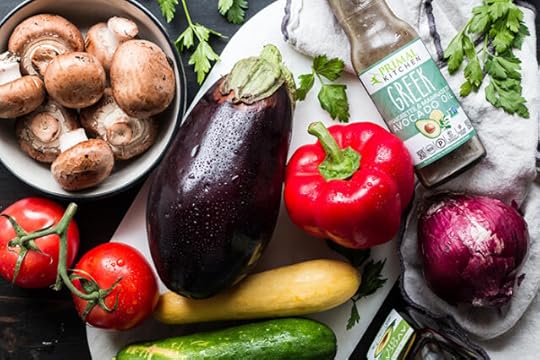
Directions
In a bowl, combine ¼ cup of Primal Kitchen Greek Dressing, Primal Kitchen Avocado Oil, garlic, salt and pepper. Toss all of the vegetables in the sauce. Allow the vegetables to marinate for 30 minutes, tossing them once or twice during this time.
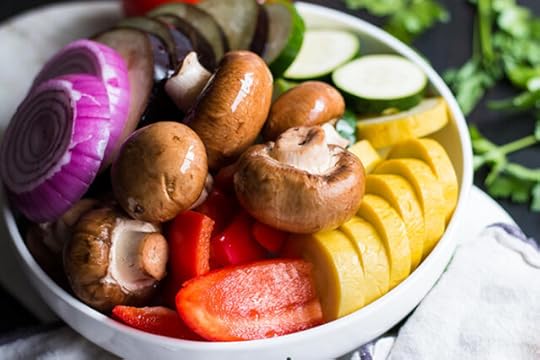
Preheat your grill over medium heat. Once hot, carefully place the vegetables on the grill. After 1-2 minutes, turn each of them 90 degrees to get nice grill marks.
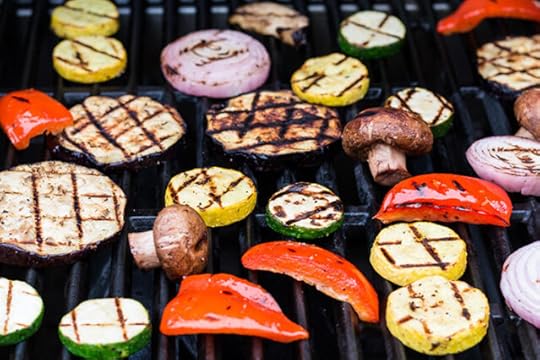 Grill for an additional 1-2 minutes, then flip over the vegetables and grill for an additional 2-3 minutes, or until they are nicely grilled on the outside and tender on the inside (this time will depend on how thick you slice them).
Grill for an additional 1-2 minutes, then flip over the vegetables and grill for an additional 2-3 minutes, or until they are nicely grilled on the outside and tender on the inside (this time will depend on how thick you slice them).
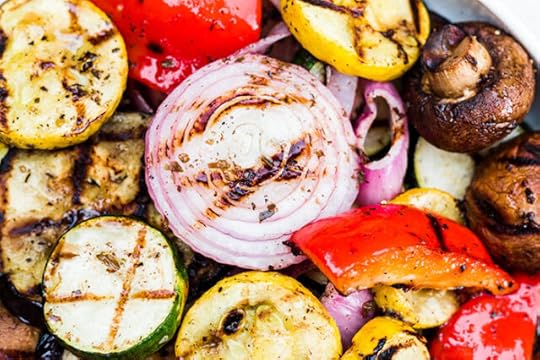 Drizzle the remaining Primal Kitchen Greek Dressing on top and garnish with chopped parsley and feta if desired.
Drizzle the remaining Primal Kitchen Greek Dressing on top and garnish with chopped parsley and feta if desired.
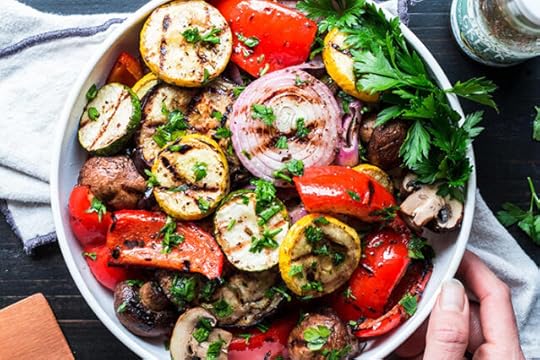

Nutrition Info (4 servings):
Calories: 222
Fat: 18g
Total Carbs: 14g
Net Carbs: 9g
Protein: 4g
dfads params=’groups=674&limit=1&orderby=random&return_javascript=1′]
The post Grilled Greek Summer Veggies Recipe appeared first on Mark's Daily Apple.



July 3, 2020
Weekly Link Love—Edition 88

Research of the Week
Physical frailty predicts COVID-19 outcomes.
If you’re lifting, getting 1.62 grams of protein per kilogram of bodyweight is a nice target.
After new analysis, Ireland reduces its “excess deaths from coronavirus” numbers. Still 13% higher than normal, but lower than previous estimations.
Evidence for coronavirus presence in Brazil as early as November 2019.
New Primal Blueprint Podcasts
Episode 431: Gina Devee: Host Elle Russ chats with author Gina Devee.
Primal Health Coach Radio, Episode 67: Laura and Erin chat with Jen James about heart-centered entrepreneurism.
Media, Schmedia
Why dads need to roughhouse with their kids.
Is there another pandemic coming?
Interesting Blog Posts
Those pesky PSCK9 inhibitors: so effective on paper, so useless (and sometimes deadly) in real life.
Social Notes
Some awesome ideas for games to play with your kids.
Don’t let this be you.
Everything Else
Science is humanity’s highest pursuit.
Got arthritis? Try barefoot.
Things I’m Up to and Interested In
I’m not surprised: Humans use smell to get around.
Interesting finding: Very low LDL is not associated with lower cardiovascular mortality. It is associated with higher all cause mortality.
It’s just everywhere these days: Plastic found in vegetables and fruits.
Another reason everyone should exercise: It improves the quality of breast milk.
A nice piece on importance of megafauna in human diets: How eating (and killing) the megafauna changed humans forever.
Question I’m Asking
Did you roughhouse as a kid?
Recipe Corner
Creamy mozzarella and tomato with chicken. Low-carb, luxurious.
Keto mac and cheese? Yes please.
Time Capsule
One year ago (Jun 28 – Jul 3)
Diastasis Recti: What to Know – What to keep in mind.
7 Foods Keto Eaters Shouldn’t Fear – A few foods that get bad raps.
Comment of the Week
“Plastic rain sounds like our version of lead pipes for the Romans.”
– We will see, Chris.
The post Weekly Link Love—Edition 88 appeared first on Mark's Daily Apple.



July 2, 2020
Self-Efficacy: Reach Your Health Goals Every Time
 Who’s that person? Nope, it’s not me. Although health coaches are a great resource for helping you set goals, overcome obstacles, and get out of your own well-intentioned way. For the record, that person is also not your spouse, your roommate, your friends, or your kids.
Who’s that person? Nope, it’s not me. Although health coaches are a great resource for helping you set goals, overcome obstacles, and get out of your own well-intentioned way. For the record, that person is also not your spouse, your roommate, your friends, or your kids.
The one person who can make you reach all your health goals is YOU.
I see you out there working hard, swapping your typical yogurt and banana breakfast for a protein-rich meal of eggs and bacon. I see you squeezing in a few sprint sessions a week and limiting blue light at night. You’re committed to doing everything right. Until, something goes wrong.
Tell me if any of these statements sound familiar.
“I’ll start over on Monday”
“I guess I’m not cut out for this”
“My husband/wife/kid keeps sabotaging me with sugary treats”
The thing is, there’s a big difference between people who think it would be really cool to reach their goals and those who unapologetically knock those goals out of the park. Trust me, I know this scenario firsthand. I’ve worked with hundreds of men and women with a desire for the latter, and a mindset for the former.
If you’re in that camp too, there is a solution. And it starts with having a deep-down belief that you have what it takes to show up for yourself each and every day and accomplish the tasks you set out to do, no matter what happens. This is what’s called self-efficacy.
What Exactly Is Self-efficacy?
According to Albert Bandura, the social psychologist responsible for this theory, self-efficacy refers to an individual’s belief in his or her capacity to execute the behaviors necessary to achieve specific results.1 In other words, if you really believe you’re capable of making a change, you’re more likely to actually make it.
Self-efficacy is also measured by how well you deal with temptation or situations that are triggers for you.You might want to lose fat, run a marathon, or kick your pint-of-ice-cream-a-night habit for good. But if you feel like you’re incapable of handling the commitment, the challenges, and the ups and downs that come with any health journey, you’re sabotaging yourself from the get-go. To get a sense of what I mean, take a look at these examples.
Examples of Strong Self-efficacy:
You look at challenging problems as tasks that can and should be mastered
You develop a deeper, more committed interest in the activities you participate in
Your dedication to yourself and your goals doesn’t waver, even when the going gets tough
You get back on track quickly after experiencing a setback
Examples of Weak Self-efficacy:
You regularly avoid tasks that you consider to be challenging
You believe that difficult tasks are beyond what you’re capable of
You typically focus on negative outcomes, obstacles, and ways you’ve failed in the past
You quickly lose confidence in your personal abilities
People with a strong sense of self-efficacy typically select more challenging goals and focus on opportunities, while people with low self-efficacy tend to fixate on obstacles. Take for instance, a study that looked at binge eating disorders in 1632 overweight men and women. Using data from a randomized clinical trial that compared a variety of weight loss interventions — including self-efficacy — the study found that having a negative emotional state was a high predictor of a poor treatment outcome. The worse the participants felt about themselves, the more obstacles they perceived, and the less weight they lost overall.2
How to Improve Your Self-efficacy
So, how do you get more of it? According Bandura, your self-efficacy stems from four distinct sources, including:
Mastery Experiences – having previously mastered a task or skill
Vicarious Experiences – seeing others who you consider a role model succeed
Verbal Persuasion – being told by influential people in your life that you have the right stuff
Emotional & Physiological States – this is the idea that depression or chronic stress can lower your belief in yourself
Taking those sources into account, I created 8 strategies that allow you to improve self-efficacy by focusing on certain areas of your life that could use a boost. These are the same strategies I use with my own clients to help them believe they’re as insanely badass as they really are.
Strategies to Improve Your Self-efficacy
Even if you have a history of being told you don’t have the right stuff or you’ve struggled to master anything short of boiling water, you can start improving your self-efficacy right now by following these steps:
Start small
Get inspired
Avoid comparison
Do the work
Watch your self-talk
Know your triggers
Adopt an “I never lose” mindset
Add up your successes
Let’s unpack these steps.
1. Start small. Choose goals that are easier to achieve. Rather than attempting to not touch another piece of bread for the rest of your life, say “I’m not eating bread today.” Need it to be even smaller? Try this on for size: “I’m not eating bread at this meal.” Smaller goals give you easy wins.
2. Get inspired. Know someone who’s totally crushing their goals? Show your support, ask them questions, and remember that if they can do it, you can too. While it can be hard to celebrate other people’s wins (especially if you’re having a tough time achieving yours), allow yourself to get inspired by their success.
3. Avoid comparison. If scrolling through your Instagram feed or chatting with your neighbor who dropped 4 dress sizes causes your self-confidence to plummet, don’t do it. Comparing yourself to others who are at different parts of their journey isn’t a good plan for anyone (see strategy #2).
4. Do the work. Be consistent with your healthy habits every day — even when you don’t want to. Sit down to an epic protein-forward meal or make movement part of your routine without expecting an immediate result. Some days will feel awesome, others won’t. Your job here is to continue to show up and put in the work.
5. Watch your self-talk. Be aware of how you talk to yourself when the going gets tough. If you constantly beat yourself up for giving up on your workouts, try turning that negative talk into something more neutral, without emotion like, “right now, I get really tired during my workouts.” It’s just a neutral awareness. For more tips on overcoming negative self-talk, read this.
6. Know your triggers. The deli with the awesome hoagie rolls? The bakery case at your grocery store? Backyard BBQs at your neighbor’s house? If certain places or situations test your ability to stay on track, avoid them for now. Or better yet, have a plan that allows you to be successful, like not going grocery shopping hungry or bringing your own Primally-friendly foods to the party.
7. Adopt an “I never lose” mindset. I’ve always loved the quote by Nelson Mandela, “I never lose. I either win or I learn.” Pretty powerful, right? This kind of mindset allows you to look for the opportunity in every situation. Instead of an all-or-nothing, win-or-lose mentality, it helps you see what you can learn – and what you can do differently next time if something didn’t go the way you’d anticipated.
8. Add up your successes. This is a key factor in building up your self-efficacy. Start keeping track of your wins, no matter how small you think they are. Grab a journal and write each one down. You’d be surprised how fast they add up.
References https://psycnet.apa.org/record/1982-07527-001https://pubmed.ncbi.nlm.nih.gov/14724662/
The post Self-Efficacy: Reach Your Health Goals Every Time appeared first on Mark's Daily Apple.



Mark Sisson's Blog
- Mark Sisson's profile
- 199 followers











